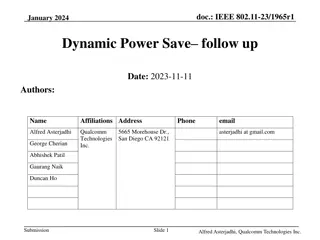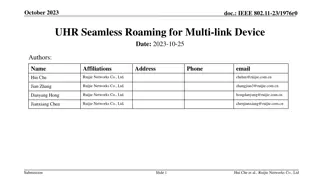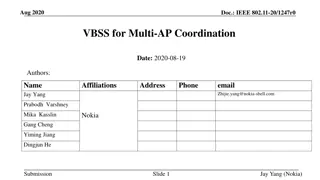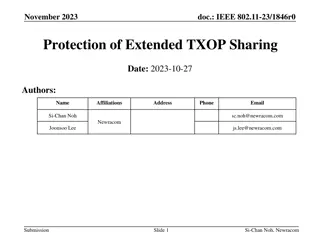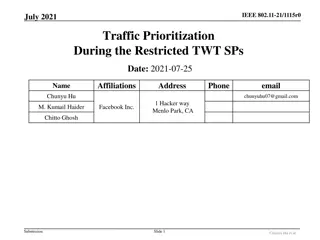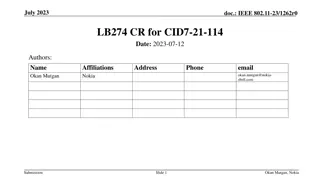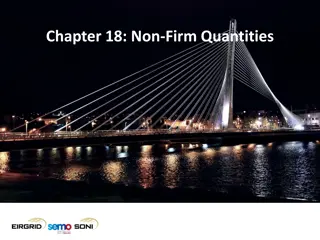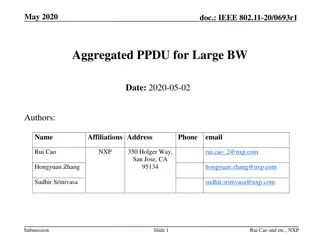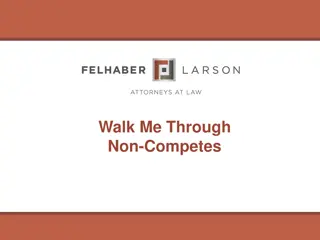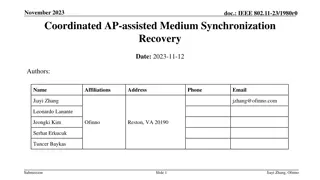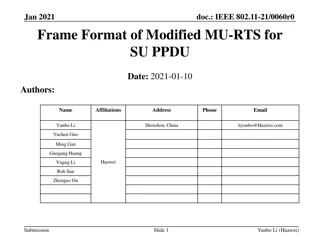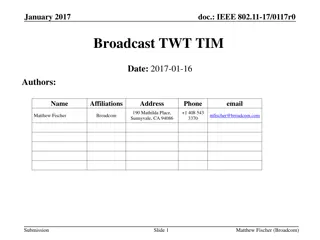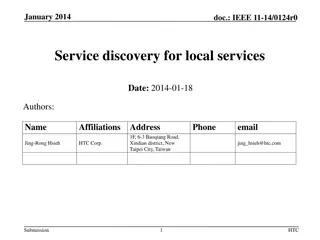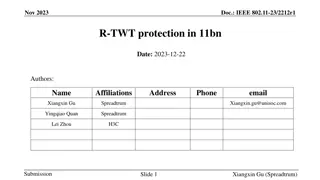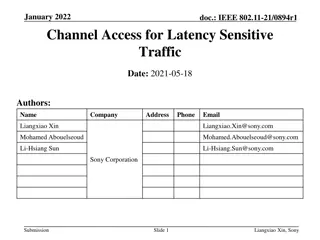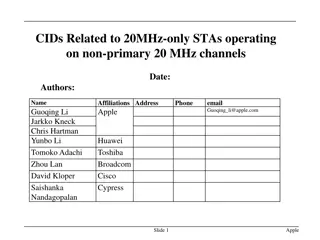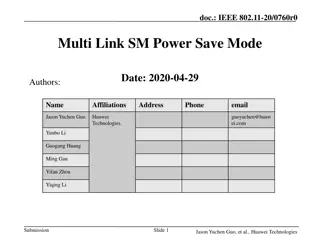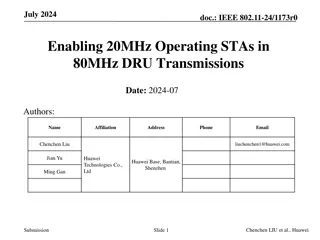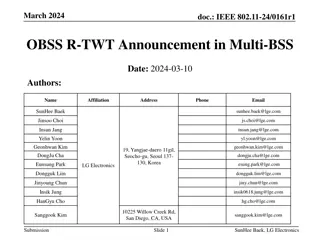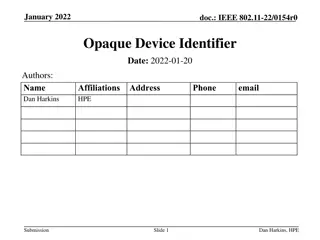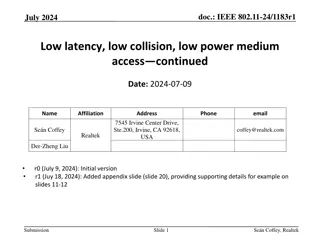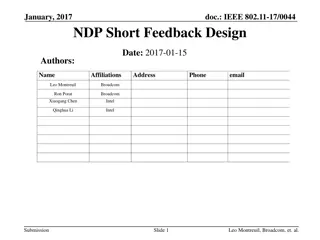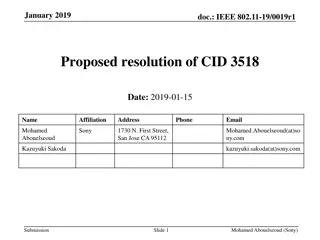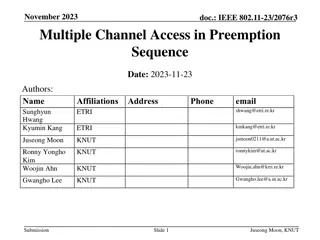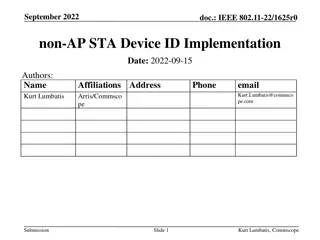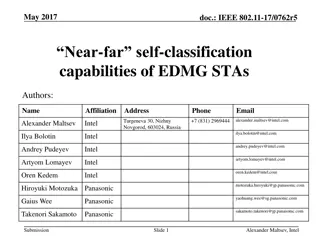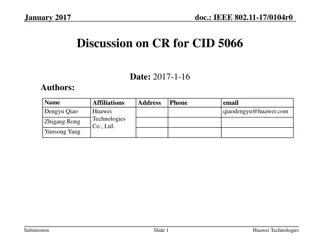IEEE 802.11-23/1874r0: Reverse TXOP Sharing for Improved Wireless Communication
This contribution presents the concept of Reverse TXOP Sharing in IEEE 802.11 networks, allowing non-AP STAs to share their TXOP with APs for efficient data transmission. The proposal addresses current limitations in TXOP utilization and offers a mechanism for enhanced Downlink and Uplink traffic ma
4 views • 11 slides
Proposal for Location Configuration Information (LCI) in IEEE 802.11 Beacons and Probe Responses
This document proposes the inclusion of Location Configuration Information (LCI) data in a standard information element broadcast in Beacons and Probe Responses within IEEE 802.11 networks. By enhancing the accessibility of infrastructure location to non-AP STAs, this proposal aims to simplify locat
1 views • 5 slides
IEEE 802.11-23/1965r1 Dynamic Power Save Mechanism Overview
The IEEE 802.11-23/1965r1 document from January 2024 discusses the implementation of a dynamic power save mechanism for WLAN devices, focusing on reducing power consumption for Access Points (APs) and non-AP stations (STAs). The proposal aims to improve power consumption efficiency for both devices
0 views • 12 slides
Seamless Roaming for Multi-link Device in IEEE 802.11-23
Seamless Roaming scheme for non-collocated AP MLD in IEEE 802.11-23 aims to enhance roaming efficiency by utilizing multi-link operation. It addresses issues of data interruption and time wastage during traditional roaming processes. The mechanism involves sharing PTKs among non-AP STAs and storing
1 views • 14 slides
Enhancing Secondary Channel Usage in IEEE 802.11 Standards
This document, IEEE 802.11-23/1935r1, delves into the intricacies of secondary channel usage within the context of IEEE 802.11 standards. Key topics covered include discussions on RU index, BW negotiation in secondary channels, methods to ensure medium synchronization when transitioning back to prim
0 views • 14 slides
IEEE 802.11-20/1247r0 VBSS for Multi-AP Coordination
IEEE 802.11-20/1247r0 discusses the concept of Virtual BSS (VBSS) for Multi-AP Coordination within the TGbe group. The VBSS infrastructure involves multiple AP nodes working on the same channel, sharing key information, and enabling seamless roaming and load balancing for improved throughput and low
1 views • 12 slides
Understanding Non-Aqueous Solvents: Types and Classification
Inorganic non-aqueous solvents play a crucial role in chemical research and industry. This article by Dr. Princy K.G. delves into the classification of solvents based on protonicity, polarity, and aqueous vs. non-aqueous nature. It explores the types of non-aqueous solvents, such as protonic and non
1 views • 29 slides
Protection of Extended TXOP Sharing in IEEE 802.11-23/1846r0
Reusing EHT's Triggered TXOP Sharing framework for extended TXOP sharing is discussed in this document, focusing on enabling sharing APs to distribute their obtained TXOP among other BSS(s). The document explores issues related to TXOP sharing for UHR STAs when a sharing AP allocates a portion of it
0 views • 12 slides
Discussion on IEEE 802.11be MLD Architecture Alignment
IEEE 802.11 TGbe is exploring MLDs within the 802 architecture, focusing on aligning MLD operations with existing 802.11 features for enhanced compatibility. The MLD architecture aims to facilitate the flow of data between MAC SAPs and PHY SAPs, extending the current framework for APs and non-AP STA
1 views • 23 slides
IEEE 802.11-21/1115r0 Traffic Prioritization Summary
The presentation discusses traffic prioritization rules during restricted TWT SPs in IEEE 802.11-21/1115r0. It revisits the topic to address pending items related to traffic restriction or prioritization, including specific rules for APs, scheduled STAs, supporting non-AP STAs, and non-rTWT STAs. Co
1 views • 14 slides
Mechanism Proposal to Avoid IRM Conflicts in IEEE 802.11 Networks
This document presents a proposal to tackle IRM collision and conflict issues in IEEE 802.11 networks, particularly focusing on addressing scenarios where multiple non-AP STAs select the same IRM. The document outlines the importance of avoiding IRM conflicts, introduces the concept of IRM Recap, an
0 views • 12 slides
IEEE 802.11-21/1737r0 Beacon and Group Frames Information
This document discusses the transmission of Beacon and group addressed frames in IEEE 802.11 networks, focusing on the impact of frame types and MCS on BSS range and transmission rate. It proposes out-of-band signaling to assist scanning STAs in determining BSS range and non-AP MLDs in selecting a l
0 views • 14 slides
Understanding IEEE 802.11-20/0410r4 Coordinated Spatial Reuse Procedure
This document presents the Coordinated Spatial Reuse (CSR) procedure in IEEE 802.11-20/0410r4, focusing on the transmission schemes and necessary information for effective spatial reuse. It outlines the topology of CSR environments, acquisition of information for CSR, CSR capability announcement by
8 views • 23 slides
IEEE 802.11-23/1980r1 Coordinated AP-assisted Medium Synchronization Recovery
This document from December 2023 discusses medium synchronization recovery leveraging multi-AP coordination for multi-link devices. It covers features such as Multi-link device (MLD), Multi-link operation (MLO), and Ultra High Reliability (UHR) capability defined in P802.11bn for improvements in rat
0 views • 8 slides
Understanding Non-Firm Quantities in Electricity Markets
Non-Firm Quantities in electricity markets involve units with non-firm access not being compensated for their non-firm capacity not getting accommodated on the system. The concept of Firm Access Quantity plays a key role in determining compensation levels for units, with differences in implementatio
0 views • 6 slides
Implications of Large-size RU Aggregation on RTS/CTS in IEEE 802.11-17
Addressing implications of large-size RU aggregation on RTS/CTS in IEEE 802.11-17, focusing on the signaling of Enhanced High Throughput Format PPDU Bandwidth and puncturing in RTS/CTS frames. Proposing the use of HE MU-RTS Trigger frame to elicit CTS response from STAs, along with different CTS for
4 views • 17 slides
Enhancing Throughput with Aggregated PPDU for Large Bandwidth IEEE 802.11 Networks
This document discusses the implementation of Aggregated PPDU to boost throughput in IEEE 802.11 networks with large bandwidth. The focus is on accommodating various STAs with different operating bandwidths and optimizing traffic flow. By utilizing Aggregated PPDU, significant gains in throughput ca
5 views • 7 slides
Understanding Non-Compete Agreements: Enforceability and Requirements
Non-compete agreements are commonly used in the United States to protect businesses from competition by former employees. To be enforceable, these agreements must meet certain requirements, including independent consideration, protection of legitimate business interests, and reasonableness in scope,
0 views • 26 slides
Coordinated AP-Assisted Medium Synchronization Recovery in IEEE 802.11-23/1980r0
This document discusses the proposal for medium synchronization recovery leveraging multi-AP coordination for multi-link devices in IEEE 802.11be EHT networks. It introduces the concept of AP-assisted medium synchronization recovery to assist non-AP STAs in transmitting frames without causing collis
0 views • 7 slides
Comparison of Trigger-based vs. Non-Trigger-based Sensing Measurement in IEEE 802.11
The document discusses the differences between Trigger-based (TB) and Non-Trigger-based (Non-TB) sensing measurement instances in IEEE 802.11 standards, focusing on who initiates the sensing measurement. TB sensing is initiated by the AP, while Non-TB sensing is initiated by a non-AP STA, enabling o
6 views • 13 slides
IEEE 802.11-21/0060r0 Jan. 2021 Modified MU-RTS Frame Format
This document discusses the frame format and structure of a modified MU-RTS (Request to Send) used in IEEE 802.11 standards for transmitting non-TB (Trigger-Based) PPDUs. The modified MU-RTS allows an Access Point (AP) to allocate time for a target Station (STA) to transmit Single User (SU) PPDUs wi
0 views • 10 slides
Proposed Resolutions to IEEE 802.11-14 Comments
Presentation of proposed resolutions to various comments (CID 26, 27, 37, 38, 40-47, 49-53, 67-71, 114, 115, 118, 124) for Tgaj draft specifications D0.01 in CC12. The responses include rewording for clarity, specifying states or signaling, and outlining procedures for non-PCP/non-AP STAs. The docum
2 views • 32 slides
Enhancing 802.11 Scheduling with Broadcast TWT and TIM Mechanisms
The January 2017 document IEEE 802.11-17/0117r0 discusses the implementation of coordinated multi-user downlink and triggered multi-user uplink in 802.11 systems to improve scheduling and reduce collisions. It proposes aligning power saving wake times using Target Wake Time (TWT) for better efficien
1 views • 17 slides
Service Discovery for Local Services in IEEE 11-14/0124r0 Document
Elaboration on non-tethering Soft AP and possible service network scenarios in the January 2014 IEEE document. It discusses the concept of non-tethering Soft APs, their operation in the vicinity, and the categories of use scenarios related to Internet access and service discovery. The document cover
0 views • 9 slides
Proposal for R-TWT Protection in IEEE 802.11-23/2212r1 11bn
A detailed discussion on considerations and proposals for R-TWT Signal Protection in 11bn networks is provided in this document. It covers topics like protection between neighboring APs, different OBSS R-TWT SPs for STAs, proposals for APs and STAs in a BSS, concluding with the importance of conside
0 views • 6 slides
Enhancing Channel Access for Latency-Sensitive Traffic in January 2022
In the documentation IEEE 802.11-21/0894r1, the focus is on improving channel access for latency-sensitive traffic through concepts like Restricted TWT (Target Wake Time). The proposal suggests methods to protect TWT Service Periods from non-TWT scheduled STAs, ensuring prioritized transmission of l
0 views • 11 slides
Proposal for Enhancing Operation of 20MHz-Only STAs on Non-Primary Channels
The proposal aims to clarify how 20MHz-only STAs can operate on non-primary 20MHz channels, introducing protocol components and considerations for seamless operation. It suggests allowing optional operation on secondary channels and specifies signaling, behavior norms, and capabilities for optimal p
0 views • 19 slides
IEEE 802.11-20/0760r0 Multi-Link Power Save Mode Extension
This document discusses the extension of dynamic SM power save mode to multi-link scenarios in IEEE 802.11-20/0760r0. By allowing non-AP STAs to control power consumption efficiently in multi-link operations, benefits such as higher peak throughput and increased reliability can be achieved. The dyna
0 views • 9 slides
Enabling 20MHz STAs in 80MHz DRU Transmissions
The document discusses the introduction, current solutions, and a proposed method for enabling 20MHz operating STAs to participate in 80MHz DRU transmissions. It addresses the challenges faced due to the uniform distribution of DRUs and proposes a subdivision approach to allow 20MHz STAs to efficien
0 views • 9 slides
Enhancing Power Save Mechanisms in IEEE 802.11 for Non-AP STAs
The document discusses improving power save mechanisms for non-AP STAs in IEEE 802.11 by focusing on reducing power consumption during listen mode, enhancing flexibility in transitions between power states, and proposing solutions to enable reception on smaller bandwidths. It emphasizes the importan
0 views • 11 slides
Enhancing IEEE 802.11 for Traffic Information Exchange
Proposal to enable non-AP STAs or non-AP MLDs to request traffic information from APs or AP MLDs, aiming to improve traffic detection accuracy by providing essential details like timing information and traffic flow characteristics. The proposal introduces a new IE called TSPEC request to facilitate
0 views • 6 slides
IEEE 802.11-24/0161r1 OBSS R-TWT Announcement in Multi-BSS
The document discusses the coordination of R-TWT schedules in Multi-BSS to enhance operation and protection. It covers how APs announce OBSS R-TWT schedules to associated STAs, ensuring efficient transmission of latency-sensitive traffic. Methods for announcing OBSS R-TWT schedules to EHT STAs and U
0 views • 13 slides
Proposal for Network-Generated Device ID Scheme in IEEE 802.11
A scheme proposing the generation of network-assigned device identifiers for STAs in IEEE 802.11 networks is outlined. The network assigns unique IDs to devices, allowing flexibility in ID formats across different networks. STAs receive and use these IDs for tracking purposes. The process involves c
0 views • 9 slides
Enhancing Medium Access Efficiency in IEEE 802.11 Networks
This presentation discusses the utilization of chirp signals for Ultra High Rate (UHR) STAs to access the medium efficiently, transmit reliably at reduced power levels, and handle interference challenges in IEEE 802.11 networks. It explores the concept of chirps, their differentiation from other pro
0 views • 20 slides
IEEE 802.11-17/0044 NDP Short Feedback Design
The document discusses the need for short simultaneous feedback from multiple STAs in IEEE 802.11 systems for improved efficiency. It introduces the NDP feedback mechanism and proposes a signaling technique to efficiently collect feedback from a high number of STAs. The mechanism involves UL MU tran
0 views • 19 slides
Proposed Resolution for Multi-Band Discovery Assistance in IEEE 802.11-19/0019r1
The document discusses a proposed resolution for CID 3518 in IEEE 802.11-19/0019r1, focusing on enhancing multi-band discovery assistance to allow STAs to communicate with non-AP/PCP STAs in the same or different BSSs. It suggests defining a mechanism for new STAs to find neighboring STAs on demand.
0 views • 16 slides
Analysis of Preemption Methods in IEEE 802.11-23/2076r3 for Latency Reduction
Discussion on preemption methods in IEEE 802.11-23/2076r3 document focusing on latency reduction objectives. Topics include coordinated preemption, random channel access, comparison between methods, and the impact on STAs performance. The document addresses concerns such as collision probability, co
0 views • 8 slides
Understanding IEEE 802.11-22/1625r0 Non-AP STA Device ID Implementation
This presentation delves into how non-AP STAs and APs determine and signal Device ID activation and usage in the context of IEEE 802.11-22/1625r0. It discusses different options and considerations for Device ID implementation to move forward with specifying this aspect efficiently while avoiding hig
0 views • 8 slides
Near-far Self-Classification Capabilities of EDMG STAs
The document discusses the problem of near-far self-classification capabilities for EDMG STAs in IEEE 802.11-17/0762r5. It focuses on sorting STAs based on range and capabilities to prevent unnecessary transmissions and interference. The AP provides information for STAs to determine whether to use l
0 views • 10 slides
Discussion on Improving Transmission Efficiency in IEEE 802.11 TWT Mechanism
This document proposes enhancements to the IEEE 802.11 TWT mechanism to address issues related to random access Resource Units (RU) utilization. By defining a mechanism to optimize RU allocation for TWT scheduled STAs, the proposal aims to improve transmission efficiency and power saving, particular
0 views • 11 slides

